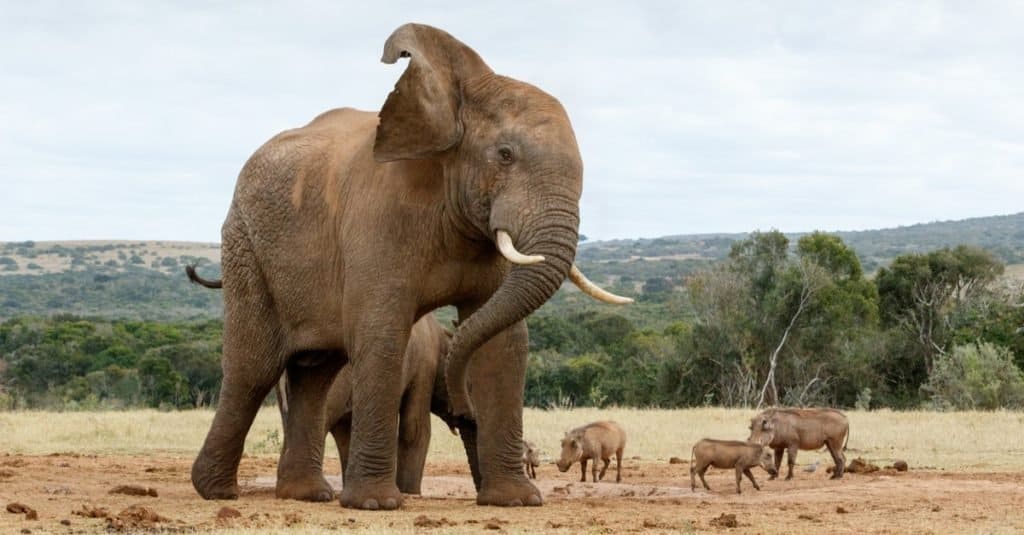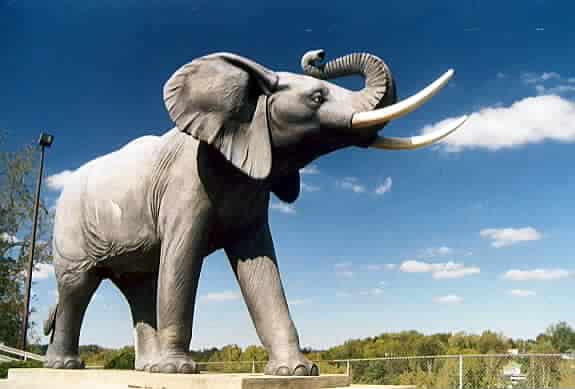Introduction
Elephants are exotic and massive animals. They have been used for centuries in battle and entertainment. While some have lived up to 86, others have not been so fortunate. One circus elephant named Jumbo died in a tragic accident at around 25 years old. Discover more about Jumbo’s life story and other amazing facts about famous elephants.
History of Circus Animals

Elephants communicate in various ways, including trumpet calls (some sounds are too low for people to hear), body language, touch, and scent. Sadly, about 90% of African elephants have been wiped out in the last century due to poaching.
©Bildagentur Zoonar GmbH/Shutterstock.com
Animals were first used in circuses in 1831. During an act in Germany, a French animal trainer named Henri Martin brought out a caged tiger to wow the audience. After Martin introduced a wild exotic animal in his act, others began to follow his lead. An American trainer, Isaac A. Van Amburgh, stuck his entire head into the mouth of a lion, which was an unprecedented act. Van Amburgh’s performance was so popular that Queen Victoria of England had a portrait of Van Amburgh and his animals painted for her.
Martin and Van Amburgh also performed with animals outside of circuses in places like theatres. They used bears, monkeys, horses, and elephants during their acts. Elephants became a staple of the American circus. Over 40 elephants were used in circuses at the beginning of the 1900s. As the circus grew more popular, exotic animals like giraffes, hippos, and polar bears were also put on display.
Unfortunately, the usage of animals in the circus was not always fun and games. Van Amburgh was known for beating his animals. Being a prominent and famed trainer, other animal trainers followed in his footsteps and abused their animals, too. Clyde Betty was another famous animal trainer known for abusing his animals.
However, the American inclusion of animals in circuses largely differed from European styles. While Americans portrayed wild animals as opponents to be abused into submission, Europeans depicted them as obedient, kind creatures that could live harmoniously with humans. Eventually, circuses were called out publicly for animal cruelty. As evidence of animal abuse was revealed over time, the circus lost popularity and eventually disappeared.
Circus Elephant Facts

A statue of Jumbo is on display in St. Thomas, Ontario, Canada where he met his untimely death.
©Einar Einarsson Kvaran/CC BY-SA 3.0 – License
The life, beginnings, and behavior of circus elephants are a mystery to many. People were typically unaware of the elephant’s reality besides what they saw in performances. However, many interesting and widely unknown facts about these creatures are worth knowing! Read on to learn fascinating circus elephant facts that everyone should know!
The First Show Elephant
Hachaliah Bailey purchased an elephant in 1805, hoping that it would be able to plow his fields. However, the elephant grew too large and ate too much food to work on a farm. Rather than giving up, Bailey decided to seize a once-in-a-lifetime opportunity and turn his elephant into a spectacle rather than a worker. He traveled around with the beast and let people see her for less than 50 cents. His showing of this elephant made him a pioneer in showing animals in circuses.
Elephants and Alcohol
Elephants were well-known for their drinking habits. Many trainers would give alcohol to elephants to calm their anxiety. Elephants would drink beer, wine, bourbon, and whiskey. One elephant named Tuski had too much to drink one day, which caused chaos in Washington. He knocked over cars, ran through lawns, and even ruined the foundation of a home.
Elephant Aggression and Casualties
When circus elephants became aggressive during a time of development called musth, they often killed humans and animals. Many trainers were killed by elephants, experiencing musth at the time. When these elephants went on a rampage, they would throw people, use their tusks to hurt them, throw cars on top of people, and trample them. In many instances, people did not know how to control these outbursts, which resulted in several injuries and casualties. Elephants still experience aggression today and can kill handlers.
Elephants Exit from the Circus
In 2016, the Ringling Brothers and Barnum and Bailey Circus decided to stop using elephants as a part of their shows. The 11 remaining circus elephants were retired to an elephant sanctuary in Florida. Many regulations against wild animal usage in circuses, alongside animal rights activism, led to elephants’ retirement. As a 200-year tradition of using elephants ended, the circus itself lost popularity and ultimately dissipated.
The Biggest Circus Elephant Ever Recorded

Elephants are very large animals.
©JohnEGoodwin/Shutterstock.com
Jumbo the Circus Elephant was an African bush elephant born in Sudan. When Jumbo was two years old, his mother died, and he was captured. The name “Jumbo” was derived from the Swahili word “jumbe,” meaning “chief.” In fact, Jumbo the elephant inspired the term.
“Jumbo” is used today to illustrate something very large. Before Jumbo became famous, the word “jumbo” had no significant meaning.
Before Jumbo joined the circus, he was held in Jardin des Plantes in Paris and London Zoo until 1882. In London, Jumbo became extremely popular. Even Winston Churchill, Britain’s prime minister during World War II, took the time to visit Jumbo and rode on the elephant’s back. Eventually, though, Jumbo experienced rage due to anxiety from being kept in enclosures. His tantrums led to him being sold to the Barnum and Bailey Circus.
However, the purchase of Jumbo was supported by few. While Jumbo became aggressive in the London Zoo and was thought to be a threat, the people of London did not want to let him go. In fact, over 100,000 children wrote letters to Queen Victoria asking her not to allow Jumbo to be sold.

Jumbo The Elephant: A Tragic End

In 1885, Jumbo was hit by a train while in Canada and many were skeptical over whether Jumbo’s death was an accident.
©unknown author/public domain – License
P.T. Barnum, who founded the Barnum and Bailey Circus, bought Jumbo for $10,000 (approximately $290,516 in today’s currency) to show him off in his circus performances. Matthew Scott, Jumbo’s trainer, traveled with the elephant to America to join the circus. Scott was able to train Jumbo in a unique way that amazed audiences. One interesting fact about Scott was that he would give Jumbo alcohol daily to calm the elephant.
Barnum used Jumbo as both an attraction and a money maker. The elephant helped the circus earn $1.75 million during a season of one year. Jumbo performed for a short time, though, as the elephant caught a terrible disease and seemed to be melting away. In 1885, Jumbo was hit by a train while in Canada. One of Jumbo’s tusks punctured his brain, and the elephant died instantly. Spectators of Jumbo’s death collected his body parts while Scott grieved his loss.
Many are skeptical over whether Jumbo’s death was an accident, as Scott did not try to move Jumbo away from the train. This lack of action caused people to believe that Scott had wanted Jumbo to be euthanized due to his disease. It appeared that Jumbo’s death was an easy way of murdering the elephant tragically without placing blame on circus owners who wanted to euthanize him.
Jumbo was approximately 10 feet and seven inches tall when he passed away at around 25 years old, but Barnum reported his height to be over 13 feet during his life. Jumbo’s skeleton is on display at the American Museum of Natural History. One could say that even in his death, Jumbo was displayed for the world to see.
Other Famous Elephants
Throughout history, other elephants have garnered attention and fame. Some famous elephants date back to 279 B.C., while others made their mark during the 20th century. Nevertheless, these creatures have amazed people for centuries and brought impactful contributions to society. Keep reading to learn about some of the most famous elephants ever recorded.
Henry III
Henry III, who ruled Britain during the Medieval period, received many wild animals as gifts from several rulers. While a polar bear and a camel might have been enough, the king also received an African elephant from King Louis IX of France. Henry III had a house built to enclose the elephant, and the animal gained popularity among the people of England. The elephant did not last long, though, as it died just two years after being given to Henry III. Supposedly, the animal passed away after consuming excessive red wine.
Pyrrhus
Pyrrhus, a general in ancient Greece, used 20 elephants to invade southern Italy in 279 B.C. Pyrrhus wanted the Romans to fear the elephants and for the beasts to block the streets of Italy so that his army could accomplish their goals. Unfortunately, Pyrrhus’s elephants got spooked easily, leading to his troops’ loss. Elephants that became afraid often trampled over soldiers in their retreat. Pyrrhus’ use of elephants in battle was successful, though, as he conquered what he set out to achieve.
Kandula
Kandula was an elephant companion to King Dutugamunu, who ruled over present-day Sri Lanka during the second century B.C. Kandula accompanied King Dutugamunu from a very young age. King Dutugamunu used the elephant in battle as a mount to survey his surroundings. With Kandura, King Dutugamunu claimed victory in many battles and praised the elephant continuously for its contributions.
Surus
In another invasion of Italy, Carthaginian general Hannibal used North African elephants to cross the Alps. Of the six elephants Hannibal brought with him, only one survived the winter. The elephant was named Surus and was ridden by Hannibal to better understand his surroundings. For over a decade, Hannibal used elephants off and on in battle. In 209 B.C., Hannibal’s elephants caused an uproar among the Romans. When the Romans injured one, the remaining elephants panicked and fled.
Lin Wang
Japan used elephants in World War II to construct roads and fortresses. Of the elephants used by the Japanese, 13 were captured by China. While six died after the war, the remaining elephants were used to build war monuments. Long after World War II, only one elephant remained. The elephant’s name was Lin Wang, which means “forest king.” Lin Wang lived in Taipei City Zoo until 2003, where he died at 86 years old.
Hanno
While kings have made a history of owning exotic elephants, religious leaders have also laid claim to such beasts. King Manuel I of Portugal sent Pope Leo X a white Indian elephant named Hanno. The elephant was well-trained, able to kneel and perform for an audience. Pope Leo X was highly impressed by the gift and permitted King Manuel I to take claim of current-day Indonesia. Hanno was the centerpiece of Roman festivals and events until 1516 when the creature passed away. After Hanno’s death, Pope Leo X commissioned a painting of the elephant by Raphael, a famous artist during the Renaissance.
The photo featured at the top of this post is © Public Domain – License / Original
Sources
- Antony Dacres Hippisley Coxe, Available here: https://www.britannica.com/art/circus-theatrical-entertainment
- Rose Heichelbech, Available here: https://dustyoldthing.com/jumbo-the-elephant/
- Wikipedia, Available here: https://en.wikipedia.org/wiki/Jumbo
- Nate Barksdale, Available here: https://www.history.com/news/10-famous-elephants-from-history
- Shaunacy Ferro, Available here: https://www.mentalfloss.com/article/74006/11-facts-about-history-circus-elephants
FAQs (Frequently Asked Questions)
How big was Jumbo the elephant?
Jumbo was approximately 10 feet and seven inches tall when he passed away at around 25 years old, but P.T. Barnum reported his height to be over 13 feet during his life.
Why do elephants show aggression?
Elephants often become aggressive during a developmental stage called musth. Musth causes an elephant’s testosterone levels to raise significantly, making them prone to aggression.
Are elephants still used in the circus?
Elephants are no longer used in the circus due to regulations and animal abuse allegations.
Thank you for reading! Have some feedback for us? Contact the AZ Animals editorial team.






